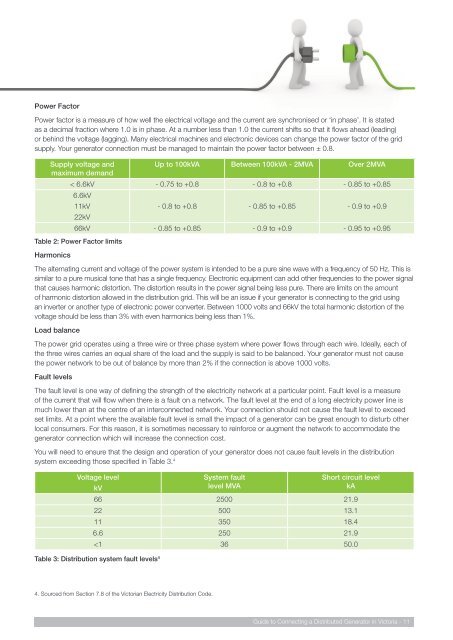Guide to Connecting a Distributed Generator - Sustainability Victoria
Guide to Connecting a Distributed Generator - Sustainability Victoria
Guide to Connecting a Distributed Generator - Sustainability Victoria
Create successful ePaper yourself
Turn your PDF publications into a flip-book with our unique Google optimized e-Paper software.
Power Fac<strong>to</strong>rPower fac<strong>to</strong>r is a measure of how well the electrical voltage and the current are synchronised or ‘in phase’. It is statedas a decimal fraction where 1.0 is in phase. At a number less than 1.0 the current shifts so that it flows ahead (leading)or behind the voltage (lagging). Many electrical machines and electronic devices can change the power fac<strong>to</strong>r of the gridsupply. Your genera<strong>to</strong>r connection must be managed <strong>to</strong> maintain the power fac<strong>to</strong>r between ± 0.8.Supply voltage andmaximum demandUp <strong>to</strong> 100kVA Between 100kVA - 2MVA Over 2MVA< 6.6kV - 0.75 <strong>to</strong> +0.8 - 0.8 <strong>to</strong> +0.8 - 0.85 <strong>to</strong> +0.856.6kV11kV22kV- 0.8 <strong>to</strong> +0.8 - 0.85 <strong>to</strong> +0.85 - 0.9 <strong>to</strong> +0.966kV - 0.85 <strong>to</strong> +0.85 - 0.9 <strong>to</strong> +0.9 - 0.95 <strong>to</strong> +0.95Table 2: Power Fac<strong>to</strong>r limitsHarmonicsThe alternating current and voltage of the power system is intended <strong>to</strong> be a pure sine wave with a frequency of 50 Hz. This issimilar <strong>to</strong> a pure musical <strong>to</strong>ne that has a single frequency. Electronic equipment can add other frequencies <strong>to</strong> the power signalthat causes harmonic dis<strong>to</strong>rtion. The dis<strong>to</strong>rtion results in the power signal being less pure. There are limits on the amoun<strong>to</strong>f harmonic dis<strong>to</strong>rtion allowed in the distribution grid. This will be an issue if your genera<strong>to</strong>r is connecting <strong>to</strong> the grid usingan inverter or another type of electronic power converter. Between 1000 volts and 66kV the <strong>to</strong>tal harmonic dis<strong>to</strong>rtion of thevoltage should be less than 3% with even harmonics being less than 1%.Load balanceThe power grid operates using a three wire or three phase system where power flows through each wire. Ideally, each ofthe three wires carries an equal share of the load and the supply is said <strong>to</strong> be balanced. Your genera<strong>to</strong>r must not causethe power network <strong>to</strong> be out of balance by more than 2% if the connection is above 1000 volts.Fault levelsThe fault level is one way of defining the strength of the electricity network at a particular point. Fault level is a measureof the current that will flow when there is a fault on a network. The fault level at the end of a long electricity power line ismuch lower than at the centre of an interconnected network. Your connection should not cause the fault level <strong>to</strong> exceedset limits. At a point where the available fault level is small the impact of a genera<strong>to</strong>r can be great enough <strong>to</strong> disturb otherlocal consumers. For this reason, it is sometimes necessary <strong>to</strong> reinforce or augment the network <strong>to</strong> accommodate thegenera<strong>to</strong>r connection which will increase the connection cost.You will need <strong>to</strong> ensure that the design and operation of your genera<strong>to</strong>r does not cause fault levels in the distributionsystem exceeding those specified in Table 3. 4Voltage levelkVSystem faultlevel MVAShort circuit levelkA66 2500 21.922 500 13.111 350 18.46.6 250 21.9




